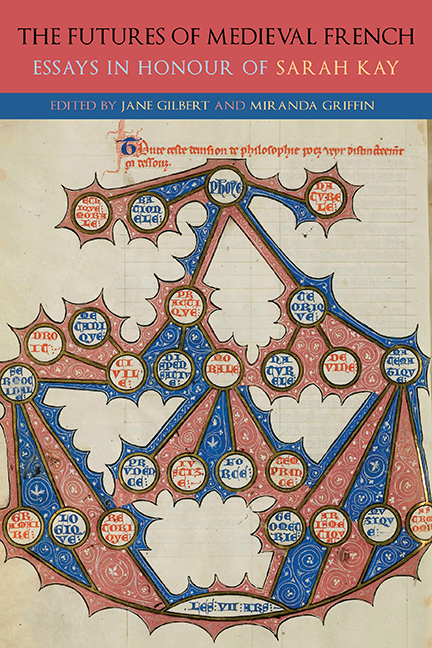Book contents
- Frontmatter
- Dedication
- Contents
- List of Illustrations
- List of Contributors
- List of Abbreviations
- Introduction
- Part I Subjectivity in Troubadour Poetry
- Part II The ‘Chansons de geste’ in the Age of Romance: Political Fictions
- Part III Courtly Contradictions: The Emergence of the Literary Object in the Twelfth Century
- Part IV The Place of Thought: The Complexity of One in French Didactic Literature
- Part V Parrots and Nightingales: Troubadour Quotations and the Development of European Poetry
- Part VI Animal Skins and the Reading Self in Medieval Latin and French Bestiaries
- Afterword
- General Bibliography
- List of Manuscripts
- Bibliography of Work by Sarah Kay
- Index
- Gallica
Rupturing Skin through the Power of Vox
Published online by Cambridge University Press: 27 May 2021
- Frontmatter
- Dedication
- Contents
- List of Illustrations
- List of Contributors
- List of Abbreviations
- Introduction
- Part I Subjectivity in Troubadour Poetry
- Part II The ‘Chansons de geste’ in the Age of Romance: Political Fictions
- Part III Courtly Contradictions: The Emergence of the Literary Object in the Twelfth Century
- Part IV The Place of Thought: The Complexity of One in French Didactic Literature
- Part V Parrots and Nightingales: Troubadour Quotations and the Development of European Poetry
- Part VI Animal Skins and the Reading Self in Medieval Latin and French Bestiaries
- Afterword
- General Bibliography
- List of Manuscripts
- Bibliography of Work by Sarah Kay
- Index
- Gallica
Summary
AS SARAH KAY notes (Animal Skins: 1), the late twelfth and early thirteenth centuries witnessed the height of the production of bestiary materials, works that detail the natures of non-human animals for the instruction of humans. Kay draws attention to the materiality of bestiary texts in medieval manuscripts, noting in particular the visual and haptic aspects of the reader's relation to skin: the skin of the page and the depictions of the animal skins pictured within them. She notes skin scholarship's twofold recognition of skin as a surface of inscription and a container for identity, linking this work to her earlier interest in subjectivity. In effect a bestiary's parchment page merges the embodied subject and the subject that depends on textuality, probing the boundaries of both. Just as Kay added to Martha Rust's assertion of ‘codicological consciousness’ on the part of the reader, ‘a codicological unconscious in which reading can be subject to contingent interference from the look and feel of the page itself’ (Animal Skins: 142), I would here like to extend Kay's perspective by proposing a further sensory aspect of the page's ‘codicological unconscious’: the sonic.
The skin on which the bestiary is written proposes a porousness between human and animal, allowing the possibility for a bestiary page to perform a suture between content and medium, between reader and page: ‘a feedback loop between the page as an animal surface and the texts and images it supports’ (Animal Skins: 4). The parchment page can also be viewed as obscene, since it is a flayed creature, with the inside, the flesh side, brought to view on the surface at the same time as the hair side is de-haired, removing a vital aspect of the animal's identity. The book's own ruptures are visual and tactile too, with holes and splits in the parchment visible and available to touch.
As a complement to the visual and tactile aspects of bestiary manuscripts charted in Animal Skins, I will concentrate here on the role of aurality and orality in the most unusual of the bestiary materials that Kay considers, Richard de Fournival's Bestiaire d’amours (before 1260), a work she notes as being ‘unmoored from its theological moorings’ (Animal Skins: 51) and thus unlike the other, very specifically theological purposes of bestiary materials in French and Latin bestiaries.
- Type
- Chapter
- Information
- The Futures of Medieval FrenchEssays in Honour of Sarah Kay, pp. 301 - 313Publisher: Boydell & BrewerPrint publication year: 2021

